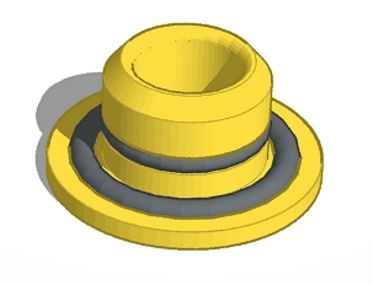
Overflow Stopper
thingiverse
This is a device to block the overflow hole on a bathroom sink. It only fits round holes but can be scaled to fit different sized round holes. Why would you want to block the overflow hole on a sink? If the trap (u-bend) has become clogged so that the sink doesn't drain properly, one solution is to use a sink plunger. Do this without blocking the overflow hole, and you end up with a jet of foul water that typically hits you in the midriff. Block the hole by holding a normal sink plug over it (say) and, often as not, it slips and you end up with a finer jet of foul water that hits you in the face. This locates firmly in the hole and, even if water gets past the O-rings, the flange will prevent it from squirting straight at you. The O-rings themselves aren't meant to be printed, though they could be printed in a flexible material or made from PLA and used to make molds to cast silicone sealant into making soft silicone O-rings. Mostly, they're just there to show the size that suits this device as initially dimensioned. O-rings stretch, so a smaller one will be okay if you increase the diameter by a few millimeters, but the larger one needs to fit snugly in its groove without stretching. On the one I made, I degreased the larger O-ring and glued it into the groove using cynoacrylate (superglue/Sekund Kleber) - specifically, I used Loctite's sold for plastics use with an activator pen - I painted the activator onto the O-ring and dripped glue in the groove. The O-rings I used are nitrile, but the gluing ability of your O-rings may vary. There's a subtlety to the sizing of this that is worth explaining. The kind of porcelain sink that this is meant for has a round overflow hole, but simply by virtue of the manufacturing process, the hole will tend to have a diameter that narrows in the middle. If the smaller O-ring is positioned so that it goes just past the narrow bit when the bigger O-ring presses against the surface, then the smaller O-ring will snap the unit into place - see the two diagrams. Obviously, the position of the ring will depend on the height of the device, so if you have to scale it to fit your sink, scale the diameter so that it's about 1mm less than the nominal hole diameter and the height so that the O-ring is positioned as per the diagram when inserted. The hole this is meant to fit is a nominal 25mm, between about 24.5mm and 25.5mm at its narrowest. Accordingly, the protruding part of this device is 24mm in diameter. The height of the crest of the small O-ring above the large one is 4mm as designed, and the overall height of the device is 19mm, so to move the small O-ring groove to a different height, scale the overall height in the same proportion - for example, to get it to be 4.5mm instead of 4mm, multiply 19 by (4.5 divided by 4) to get the new height. EDIT: Added a second kind, for a type of kitchen sink overflow that's raised above the surface.
With this file you will be able to print Overflow Stopper with your 3D printer. Click on the button and save the file on your computer to work, edit or customize your design. You can also find more 3D designs for printers on Overflow Stopper.
